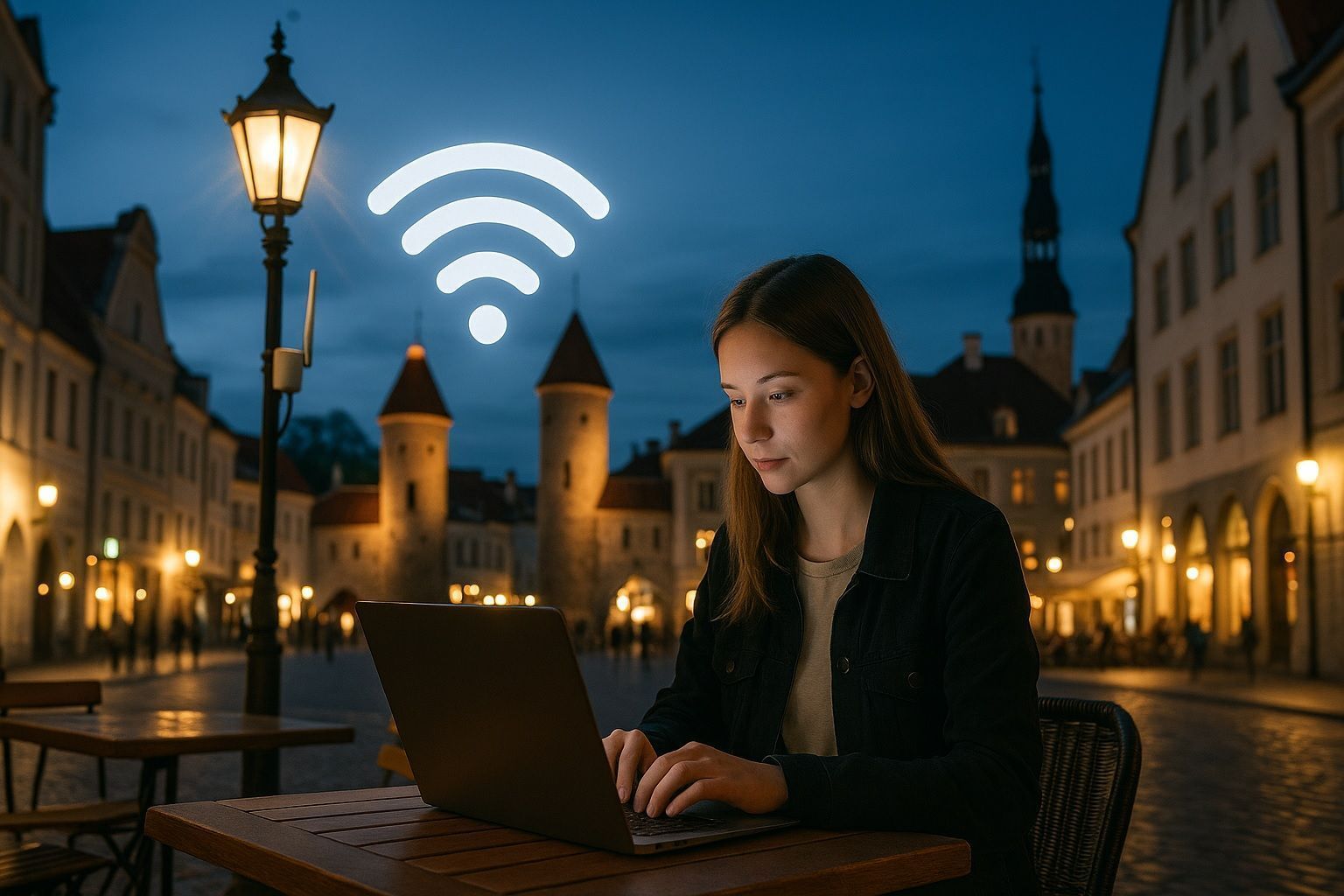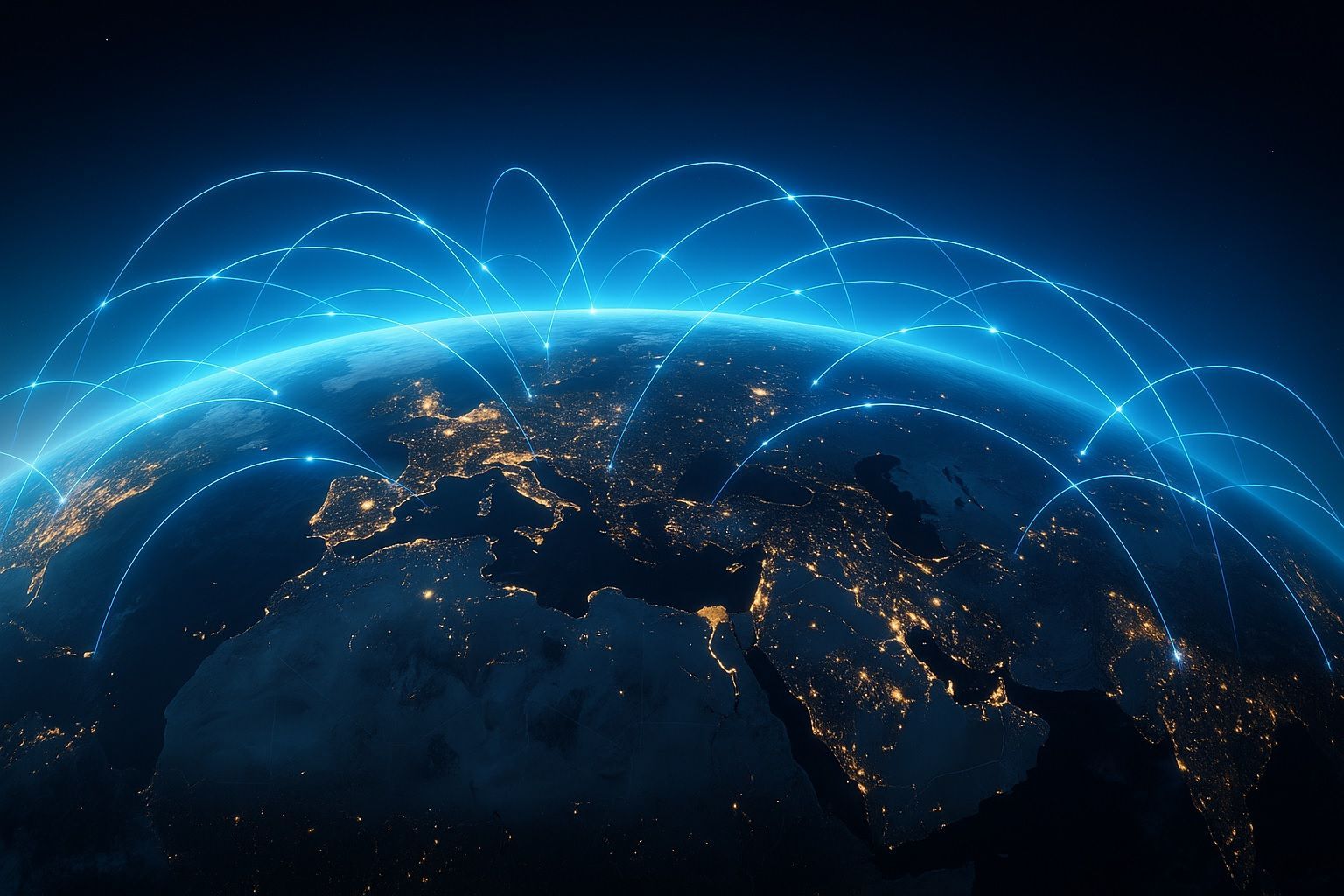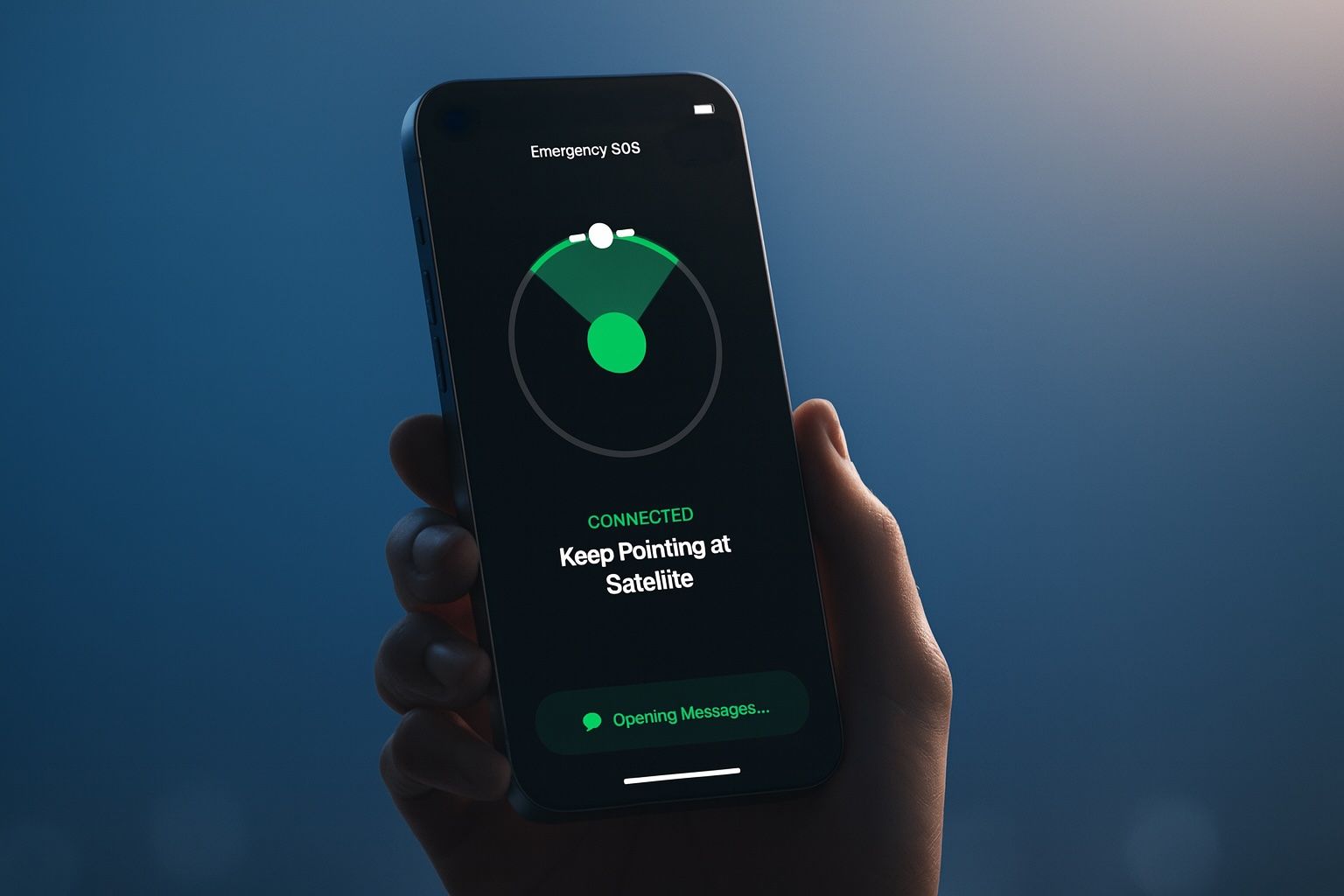- As of 2022, about 94.9% of Estonian households could access fixed broadband, and 78.9% had gigabit-speed FTTP, well above the EU average.
- The government targets full gigabit coverage by 2030, with about 77% of households connected to a Very High Capacity Network by 2023.
- 4G coverage exceeds 99% of the population, and by 2023 5G coverage reached 87% of households, with Telia 5G reaching about 75% of the population by October 2023 and Elisa around 75% by early 2024.
- By 2024, 93.7% of the population were internet users and 92.9% of households had internet access.
- Starlink entered Estonia in August 2022, delivering 50–200 Mbps downlinks at roughly $80 per month, used to serve remote locations and supporting autonomous vehicles in Ukraine.
- Estonia built a ~7,000 km open-access EstWin fiber backbone, bringing fiber within 1.5 km of 98% of households by 2020.
- About 120,000 rural households lacked a fast fixed connection in 2021; roughly 45,000 were expected to gain fiber by end-2023, leaving about 75,000 in white areas needing state support.
- Public Wi-Fi has been a focus since 2006, with hundreds of free Wi-Fi zones, and in 2015 Estonia ranked second in the world for public Wi-Fi speed and availability.
- Internet voting began in 2005, and by 2023 over 40% of votes were cast online as part of Estonia’s e-Estonia digital government services.
- Estonia’s space initiatives include ESTCube-1 launched in 2013 and a planned commercial communications satellite around 2026 with ESA support to test high-speed optical data downlinks.
Estonia, often dubbed a Baltic tech star, has transformed itself into one of the most digitally advanced societies. From nearly universal internet access on the ground to new connectivity options beaming down from satellites, Estonia’s internet revolution touches every corner – even rural farms and outer space. This report explores the state of Estonia’s internet infrastructure, service providers and pricing, rural inclusion, speed and coverage stats, satellite internet, government digital policies, future plans, and how Estonia stacks up against Europe and the world.
Current State of Internet Infrastructure
Fixed Broadband (Fiber & DSL): Estonia has aggressively built out high-speed fixed networks, with fiber-optic infrastructure playing a dominant role. As of 2022, about 94.9% of Estonian households could access fixed broadband, and 78.9% had access to gigabit-speed fiber-to-the-premises (FTTP) networks [1]. Notably, Estonia has virtually no modern cable (DOCSIS 3.1) systems [2] – instead, fiber-optics are the backbone, with legacy DSL filling some gaps. The country’s FTTP coverage (~79%) exceeds the EU average (~50%)】 [3], reflecting Estonia’s leapfrogging of older cable technology in favor of fiber. National broadband plans target full gigabit coverage by 2030 (all households and businesses) [4].
Mobile Networks (4G & 5G): Wireless coverage is extensive. 4G LTE reaches over 99% of the population [5], providing a baseline of connectivity even in remote areas. Estonia was initially slow in rolling out 5G – as of 2022 it had allocated spectrum later than many EU countries, leaving 5G availability at only ~18% of populated areas in early 2022 [6]. However, since mid-2022, rapid progress has been made: auctions of 700 MHz and 3.6 GHz spectrum were completed in 2022, and by 2023 5G coverage jumped to 87% of households (up from 43% in 2022) [7]. All three major operators (Telia, Elisa, Tele2) launched 5G networks by late 2022 [8]. Telia’s 5G network alone covered ~75% of the population by Oct 2023 and is on track to reach 95% by end of 2024 [9]. Similarly, Elisa reported 5G reaching ~75% of the population by early 2024 and even activated the first 5G standalone core network, boasting the largest 5G footprint in Estonia as of Q1 2025 [10] [11]. In practice, this means urban centers and major towns enjoy fast 5G, while rural areas are increasingly coming online as new base stations light up every week.
Internet Penetration and Usage: The vast majority of Estonians are internet users. By the start of 2024, an estimated 93.7% of the population was online [12], and 92.9% of households had an internet connection [13]. This places Estonia among Europe’s leaders in internet penetration. Virtually all younger and middle-aged adults are connected (over 95% of people under 55), and even 70% of seniors (65–74) use the internet [14]. The table below shows internet usage rates across regions, illustrating Estonia’s broad inclusion:
| Region (County) | Share of Population Using Internet (2024) |
|---|---|
| Rapla (highest) | 95.4% [15] – Top usage in Estonia |
| Tartu | 93.9% [16] – University/IT hub |
| Harju (Tallinn capital) | 93.4% [17] – Capital region average |
| Pärnu | 93.4% [18] – Major town area |
| National Average | 92.9% [19] – All Estonia households |
| Võru (lowest) | 85.5% [20] – Rural southeastern county |
Table 1: Internet usage by region (share of population online) in 2024. Most regions exceed 90%, with a narrower gap between urban and rural areas than in the past.
Importantly, Estonia’s quality of connectivity has improved dramatically. According to Ookla, as of May 2024 the median download speeds were about 84.7 Mbps on fixed broadband and 104.1 Mbps on mobile [21]. These speeds had jumped ~35% in one year [22], reflecting fiber upgrades and 5G rollout. With median mobile speeds now over 100 Mbps, Estonia’s mobile internet is among the fastest in Europe – even surpassing some Nordic countries’ averages. (For instance, by early 2025 Estonia’s median mobile speed ~130 Mbps edged out Sweden’s ~110 Mbps [23].) Fixed broadband speeds, while much better than a few years ago, still lag top EU fiber nations; in 2022 Estonia’s average fixed speed (57 Mbps) ranked only 64th globally [24]. But as gigabit fiber spreads, Estonia is closing the gap with Western Europe. By 2023, ~77% of Estonian households were covered by a Very High Capacity Network (VHCN) – i.e. fiber or equivalent – slightly below the EU average, but mobile broadband uptake (90% of individuals) is in line with Europe [25].
In summary, Estonia today enjoys near-universal internet availability. Fiber broadband reaches four-fifths of homes, 4G blankets the country, and 5G is quickly becoming ubiquitous. Speeds are reliable and rising fast, supporting Estonia’s data-hungry digital society.
Major ISPs, Service Types, and Pricing
Estonia’s telecom market is served by a handful of major operators that provide a mix of fiber, DSL, cable, and mobile services. It is a highly competitive market (3 main mobile networks and several fixed operators for ~1.3M population), which generally keeps prices reasonable, though there have been concerns about high prices for top-speed plans [26]. Below is a breakdown of the key Internet Service Providers (ISPs) in Estonia, their service offerings, approximate pricing, and coverage:
| ISP (Provider) | Service Types | Example Plans / Pricing | Coverage & Notes |
|---|---|---|---|
| Telia Eesti (incumbent) | – Fiber-to-the-home (FTTH) and VDSL fixed broadband – Mobile network (2G/3G/4G/5G) – TV and IT services bundled | 1 Gbps fiber ~€55/month (recently cut from ~€73) [27]. 400 Mbps fiber ~€40 (after upgrade from 300 Mbps at same price) [28]. Mobile data: unlimited 4G/5G plans ~€25–€30/month (varies by package). | Largest operator; Fiber passes ~420k homes (≈60–70% households) [29] [30]. Major cities and towns covered with fiber; DSL in some rural areas. 5G network (~500+ base stations) covered 75% of population by late 2023, aiming for 95% in 2024 [31]. 4G covers ~99% pop. |
| Elisa (Finland-owned) | – Fiber and Cable broadband (DOCSIS upgraded to fiber/coax) – Mobile network (2G/3G/4G/5G) – TV (Elisa Elamus) and content services | 1 Gbps fiber ~€44–€50/month (37% price drop in 2025) [32]. 500 Mbps cable/fiber ~€30–€40/month (estimated). Mobile data: unlimited plans typically ~€20–€25/month. | Second-largest operator. Cable/Fiber network covers major urban areas (109k fixed broadband customers as of 2025) [33]. Launched 2.5 Gbps top-speed home service in 2025 (first in Estonia) [34]. 5G coverage ~75% pop by 2024 [35], including first 5G standalone core, making Elisa briefly #1 in 5G footprint [36]. 4G ~99% pop coverage. |
| Tele2 (Sweden-owned) | – Mobile broadband only (no wired network) – 4G/5G home internet via wireless routers – Some fixed wireless (LTE) in rural areas | “Home 5G” unlimited ~€35/month (includes router); speeds ~200–300 Mbps [37]. “Home 4G” unlimited ~€25/month (speeds vary ~30–60 Mbps) [38]. Mobile phone plans with unlimited data ~€20–€25. | Third mobile operator (no legacy fixed lines). Focuses on Fixed Wireless Access (FWA) for home internet. 5G network coverage ~70% of population by end 2024 (doubled during 2024) [39]. 4G covers ~99% pop. Leverages shared rural networks (state fiber backbone) for reach. Lower cost structure and aggressively priced packages. |
| Others (smaller ISPs) | – STV: Cable internet (older network being upgraded). – Apollo: New fiber ISP using state-funded open fiber – Elektrilevi (wholesale): Power grid operator building rural fiber – Various local/regional WISPs | Apollo 1 Gbps ~€33/month in pilot areas [40] (very cheap gigabit using subsidized network). STV cable plans ~€20–€30 for 100 Mbps (legacy coax). | Apollo (backed by TV provider) launched in 2022 on the open-access fiber network in rural Saku and Kohila, offering gigabit for €33 [41] – undercutting incumbents (Telia/Elisa were €70 for 1 Gbps at the time) [42]. Elektrilevi (the national grid co.) has built ~7000 km of fiber backbone for rural connectivity [43], which ISPs can lease to reach remote customers. Several wireless ISPs serve sparsely populated areas via WiMAX, Wi-Fi or LTE. |
Table 2: Major Internet providers in Estonia, their services, example prices, and coverage. Note: Prices are approximate monthly fees for consumer plans (as of 2023–2025) and may require contracts. Currency is EUR. Coverage refers to population or household reach.
Despite robust competition, price concerns have been raised, especially for ultra-fast plans. In late 2022, Estonia’s gigabit internet cost (€70+/month) was higher than in many countries – twice the price of Finland’s DNA (€35) and far above Latvia’s (~€20) [44]. Telecoms argued this reflected prior investments and smaller market size. The good news is that by 2024–25, providers reacted by slashing gigabit prices (Telia down ~25%, Elisa down 37%) [45] [46], making top-tier speeds more affordable. Today a gigabit connection in Estonia can be had for ~€50 or less, marking a significant improvement in value for consumers. Lower-tier broadband (100–300 Mbps) and mobile data plans in Estonia are reasonably priced and “unlimited” mobile data is common – enabling widespread usage (mobile data consumption has grown rapidly each year [47]). Overall, the ISP landscape is healthy, with Telia and Elisa offering full-service bundles (mobile, fiber, TV) and Tele2 providing a price-disruptive wireless alternative. This competitive dynamic drives ongoing investments in network upgrades and innovative offerings.
Rural Access and Digital Inclusion
Ensuring rural and remote areas aren’t left behind has been a priority in Estonia’s digital strategy. The country’s population is about 30% rural [48], scattered across forests and islands, which poses a challenge for network deployment. To address this, Estonia embarked on ambitious inclusion programs:
- EstWin and the Broadband Backbone: Over the past decade, Estonia built a state-subsidized fiber backhaul network of ~7,000 km that blankets the entire country [49]. This open-access network (spearheaded by the Estonian Broadband Development Foundation under the EstWin project) aimed to bring high-capacity fiber within 1.5 km of 98% of households by 2020 [50]. By providing fiber “middle-mile” connectivity to rural towns and villages, it lowered costs for any ISP to extend last-mile connections. The network is available on equal terms to all telecom operators and even government agencies, at affordable rates, to spur rural coverage [51]. This model of public-private partnership has been crucial – essentially, the state laid the fiber highways, and private ISPs build the on-ramps to individual homes.
- Fiber to Farms and Villages: Despite the backbone, the final stretch to farms can still be costly. As of 2021, an estimated 120,000 rural households (and companies) lacked a fast fixed connection (defined as 30+ Mbps). Through ongoing projects, about 45,000 of those were expected to get fiber access by end of 2023, aligned with EU “Gigabit Society 2025” targets [52]. That leaves roughly 75,000 addresses in “white areas” – locales where the market alone won’t deliver connectivity – which require additional state investment and co-operation with telcos [53]. The government has allocated EU Recovery funds (e.g. €24 million from the Recovery and Resilience Facility) specifically to support VHCN rollout in rural areas [54]. In practice, grants and tenders are given to ISPs to build fiber or wireless links to small communities that would otherwise be unprofitable.
- Wireless Solutions for Remote Areas: For very sparsely populated spots – think remote Baltic islands, national parks, or isolated farms – Estonia leverages wireless and even satellite tech (discussed more below). All three mobile operators provide fixed-4G or 5G wireless broadband offerings that target rural customers as a substitute for wired lines. A 4G/LTE router can deliver 30–50 Mbps over cellular networks to a home, and 5G routers now push 100–300 Mbps, which is a game-changer for countryside entrepreneurship and education. Given that mobile networks cover nearly 100% of Estonia, this has been a quick fix in areas awaiting fiber. Additionally, point-to-point radio links and Wi-Fi-based community networks (often set up by local initiatives in the 2000s) have provided internet in some villages.
- Public Wi-Fi and Community Access: Estonia was an early pioneer of public Wi-Fi as a digital inclusion tool. Free Wi-Fi hotspots abound – in city centers, libraries, buses, even campgrounds. As early as 2006, there were hundreds of certified free Wi-Fi zones, and by one survey Estonia had the 2nd best public Wi-Fi in the world (2015) in terms of speed and availability [55]. A visitor today can get online in a rural municipality building or a café in the middle of a bog hike, thanks to these hotspots. This ubiquity of Wi-Fi ensured that even those who couldn’t afford home internet (or tourists without mobile data) could still get online when needed, fostering digital inclusion.
- Digital Skills and E-services: The government also recognizes that access is not just physical. Programs to improve digital literacy among the elderly and disadvantaged groups have been implemented so that once connected, people can fully benefit. Estonia’s e-government services (from online voting to e-health) are designed to be simple and accessible, encouraging all citizens to participate in the digital society. Notably, by 2024 over 95% of 16–54 year-olds were internet users, but usage drops among seniors [56]. Initiatives like village internet days and library training aim to narrow this generational gap so no one is left offline.
Overall, Estonia has largely bridged the urban-rural digital divide in basic connectivity – 98% of the country has some form of internet access [57]. The focus now is on upgrading rural connections from “basic” to “ultra-fast.” Under the Digital Agenda 2030, the goal is for every inhabited household, company, and authority in rural areas to have access to at least 100 Mbps, upgradeable to 1 Gbps [58]. Innovative co-op models (like communities co-funding fiber deployment) and continued state support are driving that final mile. Thanks to these efforts, an Estonian farmer in a remote parish can stream e-learning videos or file digital forms almost as easily as a techie in Tallinn – fulfilling Estonia’s ideal of internet as a universal utility.
Internet Speed and Coverage Statistics
How fast and how far-reaching is Estonia’s internet, by the numbers? We’ve alluded to many stats above; here we consolidate key speed and coverage metrics:
- Household Coverage: ~95% of households have access to a fixed broadband network [59] (the remainder likely use mobile/satellite solutions). Fast broadband (30 Mbps+ networks) cover ~90% of households, on par with EU average [60]. Gigabit-capable networks (fiber or equivalent) reached ~77% of households by 2023 [61], slightly below EU average (~80%) but rising. Notably, rural household coverage with fixed broadband, while improved, still lags urban areas (one report noted Estonia was below EU average in rural broadband availability) [62] – hence the ongoing rural fiber projects.
- Mobile Coverage: Nearly 100% of the population is under 4G LTE coverage. 5G covered ~87% of households by 2023 [63] and is expected to approach near-universal in populated areas by 2025. Importantly, coverage means the signal is available, though signal quality can vary. Estonians benefit from excellent geographic coverage – you can get a mobile signal in almost any habited spot, and indeed 91–93% of time users have 4G or better connection according to OpenSignal (2022) [64].
- Internet User Penetration: 93.7% of the population (aged 16–74) were internet users in 2024 [65]. Among households, 92.9% had internet access as of 2024 [66]. These figures are among the highest in the world – for comparison, the EU average household internet uptake was around 90% in 2024. Impressively, some Estonian counties like Rapla are >95% online [67]. The small remaining offline population is mostly elderly or in very remote locations.
- Speed Averages: According to Ookla Speedtest Global Index, by May 2024 Estonia’s median fixed broadband download was about 84.65 Mbps, and median mobile download was 104.08 Mbps [68]. These medians indicate that half of users enjoy speeds above those levels. The year-on-year improvement was substantial (+20 Mbps, ~35% increase) for both fixed and mobile [69], reflecting network upgrades. For a broader perspective:
- Fixed: The average fixed broadband speed (which can be higher than median) in early 2025 was around 91 Mbps [70]. Estonia’s fixed speeds rank roughly mid-pack in Europe – faster than many in CEE (e.g. higher than Poland or Greece), but still behind fiber leaders like Denmark, Sweden, or Romania which average 150–250 Mbps. The global rank of Estonia’s fixed internet moved up from 64th (2022) [71] to around 47th by 2025 (as higher fiber penetration kicked in).
- Mobile: Estonia shines in mobile internet – with 130+ Mbps median downloads it ranked in the top 20 globally for mobile speed in 2025 [72]. Within Europe, Estonia’s mobile networks are among the fastest (only a few countries like the UAE, Qatar, or Norway have higher mobile speeds, often due to early 5G adoption) [73] [74]. This is a notable achievement given Estonia’s earlier delay in 5G; the catch-up was rapid. Latency on mobile is also improving as 5G and fiber backhaul spread, making mobile broadband a viable substitute for fixed in many cases.
- Regional Speed Variations: Urban areas (Tallinn, Tartu) generally report the highest speeds due to dense fiber and 5G. Rural areas that rely on 4G or older DSL naturally have lower speeds. However, the gap is closing. For instance, by 2023, all three mobile networks offered solid speeds across Estonia, with average mobile downloads increasing ~70% in two years even in rural regions [75]. Many rural households that upgrade from ADSL to 5G FWA suddenly go from single-digit Mbps to 100+ Mbps. There is still a “last 10%” challenge – remote islands or sparse border areas might only get 10–20 Mbps via LTE or satellite today. But those are increasingly rare cases as both fiber and cellular networks extend outward.
In summary, Estonia’s connectivity is fast and getting faster. It may not (yet) have the absolute gigabit averages of South Korea or Singapore, but it delivers more than enough bandwidth for the digital services its citizens use (e-government, HD streaming, cloud applications, etc.). The combination of widespread gigabit fiber access and nationwide 5G by the mid-2020s will likely push Estonia’s average speeds well into triple digits. The country has effectively moved from the dial-up era, through early Wi-Fi and WiMAX experiments, to now standing on the verge of a 10 Gbps future (with Elisa already piloting 10G-EPON fiber tech) [76]. This solid foundation in speed and coverage enables Estonia to confidently host data-intensive innovations and ensure equal digital opportunity across its territory.
The Role of Satellite Internet – Connectivity Even from Space
True to its forward-looking mindset, Estonia has also been quick to embrace satellite internet as a complement to terrestrial networks. The phrase “pioneering connectivity (even from space)” isn’t just hyperbole – Estonia literally uses satellites to get online in some scenarios:
- Starlink in Estonia: SpaceX’s Starlink, a constellation of low-earth orbit (LEO) broadband satellites, became available in Estonia in August 2022 [77] [78]. This gave Estonian consumers and businesses a new option for high-speed internet, especially valuable for remote rural locations, offshore islands like Kihnu, or emergency backup. A Starlink kit (satellite dish) can deliver 50–200 Mbps downlink in areas with no fiber or 4G. By 2023, Starlink had been purchased by some rural households as an alternative where wired connections were slow – for example, to connect a distant farm or a research station in a national park. Even some innovative use-cases emerged: Estonian companies are using Starlink to control autonomous vehicles and robots. Notably, an Estonian-made unmanned ground vehicle in Ukraine was equipped with Starlink for remote operation [79] – a testament to the system’s portability and robustness. While satellite broadband is relatively pricey (Starlink service around $80/month in the region) and requires clear sky view, it has significantly improved connectivity for the hardest-to-reach areas.
- Other Satellite Services: Beyond Starlink, traditional geostationary satellite internet (VSAT) has long been available in Estonia through providers like Tooway or regional satellite telcos. These were used in the past for connecting very isolated farms or for backup links, though they had higher latency and limited speeds (~10–30 Mbps). Now with LEO constellations (Starlink, and potentially OneWeb via distributors [80]), performance is much better (latency ~20–40 ms). Companies like Levira (which manages broadcast towers) also offer satellite connectivity solutions for corporate and governmental needs [81]. Furthermore, Estonia’s Baltic neighbors and the EU are collaborating on satellite projects – for instance, the EU’s upcoming IRIS² secure satellite communications system (planned by 2027) will provide Europe-wide coverage that Estonia can leverage for government and rural broadband services. In essence, Estonia is ready to plug into any space-based internet that can enhance redundancy and reach.
- Estonia’s Space Tech Initiatives: In addition to consuming satellite services, Estonia is getting involved in creating them. In 2013 Estonia launched its first cubesat (ESTCube-1) and has since been active in nanosatellite projects. In late 2024, it was announced that Estonia’s first commercial communication satellite will be developed with European Space Agency support [82]. This smallsat (under the OPS-SAT ORIOLE project) will test high-speed optical data downlinks from LEO – effectively laser internet from space – and is set to launch in 2026 [83] [84]. While experimental, such a project shows Estonia’s intent to be not just a user but a maker of advanced connectivity tech. The satellite will also carry thermal imaging, but its optical comm payload could pave the way for future networks where satellites beam huge amounts of data (imagine multi-gigabit links) to ground stations in Estonia. This aligns with the country’s strategy of diversifying its connectivity portfolio – land, sea (submarine cables on Baltic seabed), air (drones/balloons perhaps in future), and space.
In practical terms, satellite internet remains a niche in Estonia – the vast majority of users rely on terrestrial networks. However, its importance is growing for special use cases: disaster recovery (if a storm knocks out cables, agencies can deploy satellite units), maritime and remote IoT (connecting ships in the Gulf of Finland or scientific sensors in wilderness), and providing competition in areas with an ISP monopoly. The government has kept an open mind, including satellite solutions in its broadband plans as a way to achieve 100% coverage. So while fiber trenches through the forests and 5G towers climb the skyline, Estonia hasn’t forgotten to also reach for the skies – literally using space to ensure that every last meter of its territory can have internet.
Government Policy and e-Estonia Initiatives Influencing Connectivity
Estonia’s internet revolution did not happen by accident – it was propelled by deliberate government policies and the broader “e-Estonia” vision of a digital society. Connectivity has been treated as critical infrastructure, on par with roads or electricity, and the state has actively facilitated its development:
- Declaring the Internet a Priority: As early as the mid-1990s, Estonia’s leadership (particularly President Lennart Meri and later) championed the idea that internet access is essential for economic progress. The famous “Tiigrihüpe” (Tiger Leap) program in 1996 invested heavily in computerizing schools and getting them online. By the early 2000s, Estonia had public internet access points in every library and was wiring up even remote county schools. This created a generation that grew up with the internet – thus demanding better networks as they became consumers.
- Digital Agenda and Broadband Plans: Estonia’s Digital Agenda 2030 (and earlier 2020 plan) explicitly sets connectivity targets: gigabit speeds for all by 2030, 5G in all populated areas, and making digital services accessible to 100% of the population [85]. To achieve this, the government has embraced policies like neutral regulations, spectrum allocation, and state aid for broadband. The telecom market regulator (now part of the Consumer Protection and Technical Regulatory Authority, TTJA) has been fairly pro-competition. For example, spectrum auctions were structured to ensure three viable mobile operators for 5G [86], and the regulator maintains coverage maps (netikaart.ee) to identify underserved areas [87]. Licensing of 5G was accelerated by legislative amendments in 2021 [88], after some delay, to catch up with EU timelines.
- Public Funding and EU Support: The Estonian government has not hesitated to use European Union funds and national budgets to support network expansion in “market failure” scenarios. The EU Structural Funds helped finance the EstWin fiber backbone. The ongoing rural fiber projects often use a mix of EU recovery funds and state budget. Under the Recovery and Resilience Plan, €208 million is earmarked for ICT improvements (2021–2026), including €24 million purely for rural VHCN launch [89]. Estonia smartly leverages EU Digital Europe programs – being an active participant in initiatives like the Connecting Europe Facility (for cross-border fiber links) and testing 5G corridors (e.g. a 5G highway pilot on Via Baltica).
- E-Government Driving Demand: A cornerstone of e-Estonia is that citizens can do almost all government transactions online: e-ID cards allow secure access to portals for taxes, voting, medical records, business registry, etc. This created a virtuous cycle: the government had to ensure citizens had internet access to use these services, and in turn the popularity of e-services (almost 99% of public services are online) gave people more reason to get connected. Notably, Estonia introduced internet voting in 2005 – being the first country to hold nationwide elections online. By 2023, over 40% of votes were cast via internet. This success required trust and ubiquity of internet; the state made efforts to educate people on using I-voting and ensured even rural community centers had internet so voters could log in. The policy message was clear: connectivity is a civic enabler. Estonia even toyed with making internet access a fundamental right – while not codified, in practice libraries and town halls must provide free internet so that no citizen is cut off from e-services.
- Keeping Internet Free and Open: According to Freedom House, Estonia ranks extremely high in internet freedom, placing few limits on online content and protecting user rights [90]. The government doesn’t impose censorship (aside from blocking malicious or sanctioned content like some Russian propaganda sites in line with EU sanctions [91]). This liberal environment encouraged widespread internet use and innovation (startups like Skype emerged in such an open internet climate). It’s also an attractive environment for investment by tech companies.
- Cybersecurity and Resilience: Being a highly internet-dependent nation (including critical e-voting), Estonia invests in secure network infrastructure. After facing cyberattacks in 2007, Estonia established strong cyber defense institutions (the NATO Cyber Defense Centre is in Tallinn). There are redundancies like multiple fiber routes out of the country, backup systems, and now satellite backups, to keep the country online even under duress. Government clouds have failovers and data embassies abroad. All this underscores that policy recognizes connectivity as national security.
- Promoting Competition: Regulators in Estonia have considered steps to boost competition in broadband, such as opening incumbent networks or structural separation. One idea floated was separating the wholesale and retail arms of telecoms to let new ISPs lease fiber more easily [92]. While full separation hasn’t happened, Telia and Elisa do in practice open some networks via wholesale deals. Also, the government’s support for an operator-neutral fiber network (Elektrilevi’s project) means multiple ISPs can offer service over the same rural fiber – giving rural consumers choice (like Apollo vs Telia in those areas). The state’s interest here is not picking winners, but ensuring a level playing field that ultimately improves quality and lowers prices.
In essence, Estonia’s government acts as a facilitator and guardian of the internet revolution: facilitating deployment (through funding and favorable policy) and guarding the openness and security of the online space. The “e-Estonia” brand – which encompasses the country’s digital ID, e-residency program, online services, and startup ecosystem – rests on the assumption that fast, reliable internet is everywhere. Thus, every new policy or initiative (be it self-driving cars on 5G, or nation-wide digital education) loops back to investments in connectivity. As a result, Estonia today is often cited as a model of how government vision and support can create a thriving internet ecosystem.
Future Plans and Innovations in Internet Delivery
Estonia’s connectivity journey is far from over – the country is continually pushing the envelope. Looking ahead, several expansion plans and tech innovations are on the horizon:
- Toward 100% Gigabit Coverage: By 2030, every Estonian home should have access to gigabit-speed internet [93]. This implies completing fiber-to-the-home build-outs in all remaining areas. Telia and Elisa have announced yearly expansion goals (e.g. Telia adding ~9,000 homes in 2024 across 20 regions [94], Elisa similarly extending networks). The focus will be on small towns and suburbs that still rely on older copper lines. We can expect some form of universal service funding or new public-private partnerships to get fiber into the final hard-to-reach clusters. The government’s National Digital Decade Roadmap aligns with the EU’s 2030 target: “Gigabit for everyone, 5G everywhere.” Progress is steady – by end of 2025, likely over 90% households will be passed by a gigabit network, closing the gap.
- Full 5G (and 6G prep): By 2025, Estonia will have nationwide 5G coverage (even most rural settlements). Telia aims for >95% pop coverage by end of 2024 [95], Tele2 and Elisa likely similar. The next step is improving depth of coverage – adding cell sites to increase capacity in high-demand areas (city centers, transit corridors). The use of millimeter-wave 26 GHz 5G is underway; Telia already tested 2.2 Gbps speeds on that band in mid-2023 [96]. We may see fixed wireless gigabit offerings via mmWave in dense neighborhoods as an alternative to fiber. By late 2020s, talk will turn to 6G – Estonia, as part of the Nordic/Baltic tech sphere, is likely to participate in early 6G research (Finland already invests in 6G R&D, which will spill over). The Space 5G/6G convergence is another area (leveraging ESA’s “Moonlight” and other initiatives in which Estonia is involved [97]). In short, Estonia will continue to be an early adopter of mobile network generations, ensuring it stays at the cutting edge.
- Next-Gen Fiber Technologies: On the fixed side, Elisa’s introduction of a 2.5 Gbps consumer broadband service in 2025 [98] hints at the future: multi-gigabit home connections. Telia will likely follow with XGS-PON (10 Gbps) offerings as demand grows. The “fiber to every room” concept might take hold, with new buildings pre-wired for 10+ Gbps capacity. Estonia’s tech-savvy population (and the numerous startups and IT companies) will certainly utilize these speeds for things like AI, big data, and immersive media. We may also see community mesh networks getting a revival using new Wi-Fi 7 standards, etc., to spread connectivity in creative ways.
- Cross-Border and Regional Projects: Regionally, Estonia cooperates with neighbors on connectivity. The Baltic states are working on fiber redundancy (to route internet traffic even if one country’s link fails). Also, the Rail Baltica high-speed rail project includes a 5G corridor from Poland through the Baltics – Estonia will benefit from that for transportation and IoT along the route. The country is also plugged into global internet exchanges; expect plans to maybe establish a new regional Internet Exchange in Tallinn or boost existing ones, making Estonia a bigger internet traffic hub for Northeastern Europe.
- Innovations in Last-Mile Delivery: As the last remaining unconnected Estonians dwindle in number, innovative solutions might be employed: drones or balloons (like Google Loon-like concepts) to temporarily serve remote spots during fiber build-out, or TV White Space wireless in very low-density areas. Estonia’s open tech culture means it wouldn’t be surprising to see pilot projects – for example, using autonomous robots to lay fiber cheaper, or community-owned micro-ISPs popping up to serve niche areas (leveraging that open backbone). The government has mentioned promoting innovative investment and cooperation models for infrastructure [99] [100] – this could include things like crowdsourced funding of rural broadband, or municipally-owned fiber loops that ISPs can use.
- E-Residency and Global Connectivity: Estonia’s famous e-Residency program (which gives foreign entrepreneurs a virtual Estonian ID) might also play a role. As tens of thousands of e-residents leverage Estonian digital services from abroad, the nation is motivated to ensure robust international connectivity. This might mean strengthening undersea cable links to Western Europe and the Nordics. In 2022, a new high-capacity submarine cable C-Lion route was completed to Finland, significantly increasing bandwidth. Future plans could include a direct cable to Sweden or even across the Baltic to Germany, to fortify Estonia’s global internet access (making it less dependent on any single route through neighboring countries).
- Internet Governance and Rights: Lastly, Estonia will continue to be a vocal advocate for internet freedom and digital rights on the world stage. This “softer” aspect of connectivity ensures the internet revolution remains people-centric. There are discussions in the legislature on things like avoiding overregulation of online services, balancing hate speech laws with free expression, etc. The outcome of these will shape how the internet evolves as a tool for democracy. Given Estonia’s high Freedom on the Net score (92/100, “Free”) [101], the trajectory looks to maintain an open internet environment.
In summary, Estonia’s future plans aim to make connectivity truly ubiquitous, ultra-fast, and resilient. The vision is an Estonia where nobody is out of reach of a fiber node or 5G signal, and where speeds and quality are world-class. This will cement the country’s reputation as a digital pioneer. Whether through laying more fiber, lighting up more spectrum, or launching new satellites, Estonia is determined to keep extending the frontier of what it means to be a connected nation.
Estonia vs. the World: How it Compares
By now it’s clear Estonia punches above its weight in the internet domain. But how does it compare to other countries? Here’s a brief comparative analysis:
- Against European Peers: Within the EU, Estonia is a paradoxical performer – stellar in digital services, but only middle-tier in connectivity metrics (as of a couple years ago). In the European Commission’s Digital Economy and Society Index (DESI) 2022, Estonia ranked 1st in digital public services but only 26th in connectivity [102]. The latter was due to slower 5G rollout and not the highest FTTH uptake at the time. However, by DESI 2024, many of those gaps closed: 5G coverage (87%) was near the EU average (~89%) [103] [104], and FTTH coverage (77%) was just slightly below EU average. Where Estonia lags a bit is in adoption of ultra-fast plans – by 2022 only 20% of households subscribed to 100+ Mbps, vs 41% EU average [105]. But this is rapidly improving now that gigabit prices are dropping. Compared to neighbors:
- Finland – Similar high internet use; Finland made 1 Mbps a legal right in 2010. Finland’s 5G and fiber rollouts started earlier; by 2023 Finland had ~75% FTTH coverage and over 90% 5G pop coverage [106]. Estonia is catching up fast on 5G and actually exceeds Finland in household fiber coverage (since Finland relies more on cable in parts).
- Latvia & Lithuania – These two Baltic neighbors are fiber powerhouses. Lithuania and Latvia boast some of the highest fiber penetration in Europe (over 70% of broadband subs) [107], thanks to early nationwide FTTH projects. In global speed rankings, as of 2022, Latvia and Lithuania outranked Estonia for fixed speeds, and Lithuania even beat Estonia in public Wi-Fi quality [108]. However, Estonia’s mobile internet tends to be better – e.g., Latvia’s mobile median was ~133 Mbps and Lithuania’s ~118 Mbps in 2025 (Estonia sits between them) [109]. The Baltics as a whole are well connected, but Estonia differentiates itself by the utilization of connectivity in governance and business.
- Nordics (Sweden, etc.): Sweden and Denmark have ~80–90% fiber and multi-gigabit offerings common, so they edge Estonia on fixed connectivity. Sweden’s mobile networks are excellent too. Where Estonia stands out is that it achieved comparable digital outcomes with much less spending – a testament to efficient strategy. Also, Estonia’s public Wi-Fi penetration historically beat most Nordics (only Lithuania topped Estonia in 2015 for Wi-Fi) [110], reflecting an early focus on inexpensive shared access.
- Global Benchmarks: Globally, Estonia is certainly in the top tier of internet-developed countries. In terms of internet penetration, ~94% usage is on par with advanced economies like Netherlands or South Korea. Speed-wise, as of 2025:
- Fixed broadband average (~91 Mbps) is higher than the global average (~79 Mbps) [111], but far behind leaders like Singapore (300+ Mbps) or France (287 Mbps) [112] [113]. Estonia is roughly comparable to the UK or Germany on fixed speeds now, and ahead of large countries like India, Turkey, or Russia (which have lower averages) [114].
- Mobile broadband (130 Mbps) puts Estonia among the best globally, only clearly behind a few Gulf countries and East Asian 5G leaders [115] [116]. In fact, Estonia’s mobile internet is faster than the USA’s average (which is ~168 Mbps but that includes a lot of high-bandwidth urban measurements) and vastly faster than the global mobile average (~40 Mbps). This is a huge achievement given Estonia’s size – its policy to focus on nationwide 4G early (one of the first with LTE-A) and now fast 5G is paying dividends.
- In Freedom and openness, Estonia consistently ranks top-5 worldwide (Freedom House gives it a 92/100, similar to Iceland and Canada) [117]. This contrasts with some high-tech countries where internet is restricted (e.g., Estonia’s internet is far freer than that of, say, UAE or China).
- Affordability: On a global scale, Estonian internet prices are moderate. Not as cheap as some Eastern European neighbors (Latvia’s gigabit for €20 is hard to beat), but cheaper than US or Canadian prices. A 2022 analysis found Estonia’s price-to-speed value needed improvement at the high end [118], but recent price cuts are changing that. For basic broadband and mobile data, Estonia is quite affordable relative to average income.
In conclusion, Estonia has cemented itself as a world leader in the use of the internet, if not always the absolute leader in raw metrics. The country may not have the very fastest internet on Earth (the competition for gigabit dominance continues), but it has something perhaps more important: nearly everyone is online, and they trust and use the internet daily for critical functions. Estonia’s success lies in the holistic approach – building infrastructure, yes, but also fostering a digital culture and services that fully exploit that infrastructure. This makes the Estonian example highly regarded globally, frequently studied by countries aiming to replicate its e-government or broadband strategies.
Conclusion
From the fiber in its soil to the satellites in its sky, Estonia’s internet revolution is a remarkable story of a small nation thinking big. In just a few decades, Estonia leapt from lagging under Soviet-era phone lines to offering 1 Gbps fiber and nationwide 5G. It did so through visionary government policies, tech-savvy private sector innovation, and a populace eager to embrace the digital life. Today, an Estonian can telework from a log cabin in the woods with 100 Mbps connectivity, vote for their government on a smartphone, and even access cloud services via satellites if all else fails – scenarios that would have seemed science-fiction not long ago.
As Estonia continues pioneering connectivity – trialing new technologies and expanding access – it serves as an inspiration. The lesson from this Baltic tech star is clear: when a society treats the internet as fundamental infrastructure and a tool for empowerment, transformative things happen. Estonia is not just connecting people to the internet; it’s connecting people to opportunity, to governance, to each other – and even to the final frontier of space. In doing so, Estonia has truly earned its reputation as one of the world’s most digitally advanced and innovative nations.
Sources:
- Expert Intelligence – Estonia Broadband Coverage 2022 [119] [120]
- Wikipedia – DESI 2022 and Estonia’s Connectivity Rank [121] [122]
- Freedom House (Freedom on the Net 2024) – Stats on households online, VHCN coverage, speeds, 5G [123] [124] [125]
- Statistics Estonia – 2024 internet usage data by county [126] [127]
- DataReportal (Digital 2024: Estonia) – Internet user penetration and speed growth [128] [129]
- Postimees News – Telia 5G coverage and expansion (Oct 2023) [130] [131]
- S&P Global Market Intelligence (2023) – Eastern Europe fiber rollouts (Telia EE focus) [132]
- Reddit (user report) – Tele2 home 5G vs 4G pricing and performance [133]
- Estonian World / RottenWiFi – Public Wi-Fi global ranking (2015) [134]
- ERR News – Telia gigabit price drop and package upgrades (2024) [135]
- Postimees (Carl-R. Puhm, 2022) – Comparing Estonia’s internet speed & prices to neighbors [136] [137] [138]
- Wikimedia Commons – Wi-Fi access point in Tartu (image, A. Fiedler) [139] [140] (Public domain image for reference)
- SpaceX Tweet via Wikipedia – Starlink availability in Estonia, Aug 2022 [141]
- ESA News (Nov 2024) – Estonia’s first optical communications satellite project [142] [143]
- Freedom House 2019 – Estonia’s EstWin project and Wi-Fi hotspots [144] [145]
- Baltic Times (Apr 2025) – Elisa’s achievements: 5G coverage lead, 2.5 Gbps service, price cut [146] [147]
References
1. www.expert-intelligence.com, 2. www.expert-intelligence.com, 3. en.wikipedia.org, 4. depp.oecd.org, 5. freedomhouse.org, 6. en.wikipedia.org, 7. freedomhouse.org, 8. 5gobservatory.eu, 9. news.postimees.ee, 10. www.baltictimes.com, 11. www.baltictimes.com, 12. datareportal.com, 13. freedomhouse.org, 14. stat.ee, 15. stat.ee, 16. stat.ee, 17. stat.ee, 18. stat.ee, 19. stat.ee, 20. stat.ee, 21. freedomhouse.org, 22. datareportal.com, 23. en.wikipedia.org, 24. news.postimees.ee, 25. freedomhouse.org, 26. news.postimees.ee, 27. news.err.ee, 28. news.err.ee, 29. www.spglobal.com, 30. www.mkm.ee, 31. news.postimees.ee, 32. www.baltictimes.com, 33. www.baltictimes.com, 34. www.baltictimes.com, 35. news.cision.com, 36. www.baltictimes.com, 37. www.reddit.com, 38. www.reddit.com, 39. www.telecompaper.com, 40. news.postimees.ee, 41. news.postimees.ee, 42. news.postimees.ee, 43. www.mkm.ee, 44. news.postimees.ee, 45. news.err.ee, 46. www.baltictimes.com, 47. www.operatorwatch.com, 48. datareportal.com, 49. www.mkm.ee, 50. freedomhouse.org, 51. www.mkm.ee, 52. www.mkm.ee, 53. www.mkm.ee, 54. freedomhouse.org, 55. estonianworld.com, 56. stat.ee, 57. ria.ee, 58. www.mkm.ee, 59. www.expert-intelligence.com, 60. en.wikipedia.org, 61. freedomhouse.org, 62. www.mkm.ee, 63. freedomhouse.org, 64. www.opensignal.com, 65. datareportal.com, 66. freedomhouse.org, 67. stat.ee, 68. freedomhouse.org, 69. datareportal.com, 70. en.wikipedia.org, 71. news.postimees.ee, 72. en.wikipedia.org, 73. en.wikipedia.org, 74. en.wikipedia.org, 75. www.mkm.ee, 76. www.baltictimes.com, 77. en.wikipedia.org, 78. en.wikipedia.org, 79. www.defensenews.com, 80. www.globaltt.com, 81. www.levira.com, 82. connectivity.esa.int, 83. connectivity.esa.int, 84. connectivity.esa.int, 85. depp.oecd.org, 86. 5gobservatory.eu, 87. freedomhouse.org, 88. freedomhouse.org, 89. freedomhouse.org, 90. freedomhouse.org, 91. freedomhouse.org, 92. news.postimees.ee, 93. depp.oecd.org, 94. telecomtalk.info, 95. news.postimees.ee, 96. news.postimees.ee, 97. connectivity.esa.int, 98. www.baltictimes.com, 99. www.mkm.ee, 100. www.mkm.ee, 101. freedomhouse.org, 102. en.wikipedia.org, 103. www.euronews.com, 104. freedomhouse.org, 105. en.wikipedia.org, 106. news.cision.com, 107. www.spglobal.com, 108. estonianworld.com, 109. en.wikipedia.org, 110. estonianworld.com, 111. en.wikipedia.org, 112. en.wikipedia.org, 113. en.wikipedia.org, 114. en.wikipedia.org, 115. en.wikipedia.org, 116. en.wikipedia.org, 117. freedomhouse.org, 118. news.postimees.ee, 119. www.expert-intelligence.com, 120. www.expert-intelligence.com, 121. en.wikipedia.org, 122. en.wikipedia.org, 123. freedomhouse.org, 124. freedomhouse.org, 125. freedomhouse.org, 126. stat.ee, 127. stat.ee, 128. datareportal.com, 129. datareportal.com, 130. news.postimees.ee, 131. news.postimees.ee, 132. www.spglobal.com, 133. www.reddit.com, 134. estonianworld.com, 135. news.err.ee, 136. news.postimees.ee, 137. news.postimees.ee, 138. news.postimees.ee, 139. commons.wikimedia.org, 140. commons.wikimedia.org, 141. en.wikipedia.org, 142. connectivity.esa.int, 143. connectivity.esa.int, 144. freedomhouse.org, 145. freedomhouse.org, 146. www.baltictimes.com, 147. www.baltictimes.com










